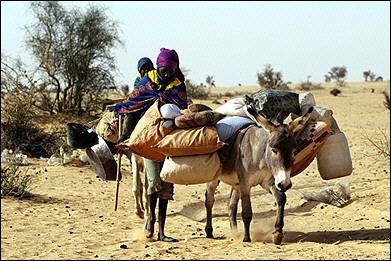100,000 Sudanese refugees languishing across border in Chad desert

TINE, Chad, Jan 28 (AFP) — Under a desert bush in northern Chad, close to the border with western Sudan, where a brutal new war is raging, an old man sits on a mat with his two wives.
Close by, another family of Sudanese refugees huddles around a dead tree as the wind blows hard. Two bundles of fodder lie on the sand near a donkey tethered to branch of the tree.
There are also a couple of camelhide bags, blue plastic basins, glasses, a teapot and several dusty blankets.
These are all the possessions the family was able to gather before fleeing Sudan’s Darfur region 10 days ago.
Rebels there have been fighting government forces backed by militia groups since February 2003. At least 3,000 civilians have since died more than 100,000 people have fled to Chad.
The numbers of refugees have increased dramatically in recent weeks amid an intensification of the conflict, according to the United Nations’ refugee agency, UNHCR.
They are now spread out along the 600-kilometer (370-mile) border, which makes it all the harder for the UN High Commissioner for Refugees to help them.
The agency opened its first camp in Chad on January 17. It now houses 826 refugees.
Brightly-dressed women bearing infants on their backs cross the desert at the rhythm of their laden donkeys.
They have just crossed the border to seek sanctuary in Chad. The minarets of the border town of Tine punctuate the horizon.
“The (government) planes bombed us from morning to night so we decided to leave,” explains one 22-year-old mother.
Local authorities say there are about 34,000 refugees in and around Tine, mostly out in the desert looking for water and anything that will pass for pasture for their livestock.
On Monday, an Antonov from Khartoum bombed the Sudanese half of Tine, just a few hundred metres (yards) from refugees the other side of a dry river that marks the border.
The attack prompted many of them to pack up and move on further inside Chadian territory.
A score of Chadian soldiers armed with AK-47 rifles monitor the few vehicles driving across the destert. Others are deployed in an all-terrain vehicle and in a pick-up truck mounted with a machine gun.
The refugees set up a shelter from the wind and the night’s bitter cold using branches and pieces of cloth.
Enveloped in a blue cloth flapping in the wind, Adam Nafisa, 30, tries to keep his baby warm. Moudjahid was born a fortnight earlier, at four in the morning in the desert.
“I don’t have enough milk,” she says, displaying her tired baby and flaccid breast.
Outside, a young girl is playing with a glass bottle, trying to fill it with sand; the hand and two feet of another child peek out of a blanket; another girl peels a gombo, a kind of courgette.
“People of the same ethnic group (Zakhawas) gave it to us in Tine market,” explained Cherif Chodgar Halime.
Zakhawas live on both sides of the border and the group’s internal solidarity has been a lifeline for many of the Sudanese refugees.
“For water we have to go to town. That’s fine for those with a donkey, but for us, to walk across the sand…” said Halime.
“It’s very hard to live here but there is no way to go home, the planes are always flying,” she added.
She and her family fled two months ago, but her husband’s watch is still set to Sudanese time.
